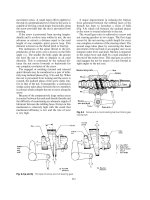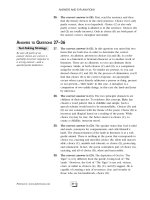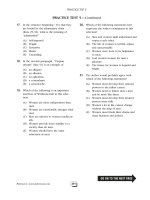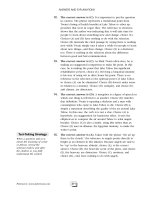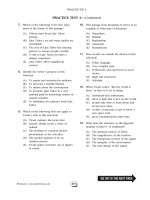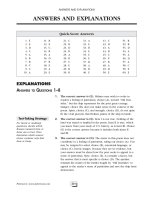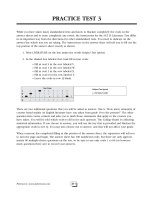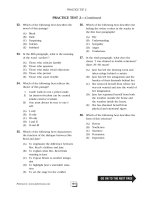SAT II success literature Episode 2 Part 7 doc
Bạn đang xem bản rút gọn của tài liệu. Xem và tải ngay bản đầy đủ của tài liệu tại đây (102.56 KB, 20 trang )
17. In the sentence beginning “ For that they
are bound by the adamantine chain ”
(lines 25–32), what is the meaning of
“adamantine?”
(A) Self-imposed
(B) Fragile
(C) Extensive
(D) Elastic
(E) Unyielding
18. In the seventh paragraph, “Utopian
dreams” (line 51) is an example of
(A) an allegory.
(B) an allusion.
(C) an aphorism.
(D) a conundrum.
(E) a synecdoche.
19. Which of the following is an important
assertion of Wollstonecraft in this selec-
tion?
(A) Women are more independent than
men.
(B) Women are emotionally stronger than
men.
(C) Men are inferior to women intellectu-
ally.
(D) Women provide more stability to a
society than do men.
(E) Women should have the same
education as men.
20. Which of the following statements best
expresses the writer’s sentiments in this
selection?
(A) Men and women shall understand and
respect each other.
(B) The life of women is terribly unjust
and unreasonable.
(C) Women were born to be helpmates
to men.
(D) God created women for men’s
pleasure.
(E) The future for women is hopeful and
bright.
21. The author would probably agree with
which of the following statements?
(A) Women must develop their rational
powers to the fullest extent.
(B) Women need to follow men’s lead
and be more like them.
(C) Women must develop their intuitive
powers more fully.
(D) Women’s lot in life cannot change
without the help of men.
(E) Women must break their chains and
enter business and politics.
PRACTICE TEST 5
PRACTICE TEST 5—Continued
➡
GO ON TO THE NEXT PAGE
291Peterson’s: www.petersons.com
22. All of the following are elements of
opposition Wollstonecraft uses to develop
her argument EXCEPT
(A) “woman will be either the friend or
slave of man” (lines 5–6).
(B) “whether she is a moral agent, or the
link which unites man with brutes”
(lines 7–8).
(C) “whoever lives only for the
passing day, and cannot be an
accountable creature.” (line 19–20).
(D) “if they be really capable of acting
like rational creatures, let them not
be treated like slaves” (lines 34–35).
(E) “Teach them, in common with man,
to submit to necessity, instead of
giving ”(lines 39–40).
23. The author would agree with which of the
following statements?
(A) Women are by nature more virtuous
than men.
(B) Because men are the breadwinners,
they deserve the better education.
(C) If women are not given opportunities
to grow and learn, all of society is
diminished.
(D) Women are flighty creatures who live
in a fantasy world of their imagina-
tions.
(E) Children should be educated so that
they are not deceitful.
24. The tone of this selection can best be
described as
(A) subtly persuasive.
(B) optimistic and uplifting.
(C) appealing to reason, convincing.
(D) argumentative and overwrought.
(E) desultory and emotional.
25. In the society of the author’s time, what
qualities in women were valued?
(A) A love for liberty and freedom
(B) A commitment to female suffrage
(C) An attitude of servility
(D) The ability to inspire respect and
consideration
(E) An attractive physical and social
demeanor
26. Which of the following devices is present
in the sentence beginning “Liberty is the
mother of virtue “(lines 69–73)?
(A) Hyperbole and metaphor
(B) Metaphor and simile
(C) Simile and allusion
(D) Personification and conundrum
(E) Personification and onomatopoeia
SAT II SUCCESS: LITERATURE
PRACTICE TEST 5—Continued
292 Peterson’s SAT II Success: Literature
Questions 27–36 refer to the two poems that follow. Read the poems carefully and then choose the
answers to the questions.
The Lamb
Line Little lamb, who made thee?
Dost thou know who made thee?
Gave thee life, and bid thee feed,
By the stream and o’er the mead;
Gave thee clothing of delight,
Softest clothing, woolly, bright;
Gave thee such a tender voice,
Making all the vales rejoice?
Little Lamb, who made thee?
Dost thou know who made thee?
Little Lamb, I’ll tell thee,
Little Lamb, I’ll tell thee.
His is callèd by thy name,
For He calls Himself a Lamb.
He is meek, and He is mild;
He became a little child.
I a child, and thou a lamb,
We are callèd by His name.
Little Lamb, God bless thee!
Little Lamb, God bless thee!
—William Blake
The Tiger
Line Tiger! Tiger! Burning bright
In the forests of the night,
What immortal hand or eye
Could frame thy fearful symmetry?
In what distant deeps or skies
Burnt the fire of thine eyes?
On what wings dare he aspire?
What hand dare seize the fire?
And what shoulder, and what art,
Could twist the sinews of thy heart?
And when thy heart began to beat,
What dread hand? and what dread feet?
What the hammer? what the chain?
In what furnace was thy brain?
What the anvil? what dread grasp
Dare its deadly terrors clasp?
When the stars threw down their spears,
And watered heaven with their tears,
Did he smile his work to see?
Did he who made the Lamb make thee?
Tiger! Tiger! Burning bright
In the forests of the night,
What immortal hand or eye
Could frame thy fearful symmetry?
—William Blake
PRACTICE TEST 5
PRACTICE TEST 5—Continued
5
10
15
20
5
10
15
20
➡
GO ON TO THE NEXT PAGE
293Peterson’s: www.petersons.com
27. What literary devices does Blake use to
create the tone, or overall feeling, of “The
Lamb”?
(A) Conceit and allusion
(B) Allusion and personification
(C) Simile and apostrophe
(D) Metaphor and simile
(E) Apostrophe and metaphor
28. Which of the following most accurately
explains why Blake chose to use many
monosyllabic words in “The Lamb”?
(A) They are less complicated to rhyme
(B) To mirror the movement of the
young animal and person
(C) To create a childlike, innocent mood
(D) To give a quick rhythm to the poem
(E) To give an uplifting feel to the poem
29. How would you characterize the creator
imagined in “The Lamb”?
(A) Exacting and merciful
(B) Silent and inaccessible
(C) Amiable and tolerant
(D) Mild and merciful
(E) Protecting and omniscient
30. How would you characterize the creator
imagined in “The Tiger”?
(A) Endangering and prejudiced
(B) Fierce and merciless
(C) Quiet and remote
(D) Powerful and awesome
(E) Demanding and retaliatory
31. What is the purpose of the images in the
fourth stanza of “The Tiger”?
I. To suggest the tiger’s ferociousness
and cruelty
II. To emphasize the tiger’s ability to
terrify
III. To arouse a sense of wonder in the
reader
(A) I only
(B) II only
(C) III only
(D) II and III
(E) I, II, and III
32. How do the words “twist,” “hammer,”
“chain,” “furnace,” and “anvil” contribute
to a metaphor for the tiger’s place of
origin?
(A) The words suggest a war zone.
(B) The poet implies a metal jungle.
(C) The words signify a hellish forge or
smithy.
(D) The words allude to a prison sweat-
shop.
(E) The words suggest the underworld of
Roman mythology.
33. What is the overall message of both
poems?
(A) The animals and the speakers in the
poems have spiritual relationships.
(B) God created the animals to serve the
needs of the human race.
(C) Animals provide joy to humanity, yet
they can be destructive, too.
(D) All beings in the world are one with
God.
(E) All living things face wonders and
terrors on this earth.
SAT II SUCCESS: LITERATURE
PRACTICE TEST 5—Continued
294 Peterson’s SAT II Success: Literature
34. Which of the following are stylistic
similarities of “The Lamb” and “The Tiger”?
I. Repetition
II. Apostrophe
III. Personification
(A) I only
(B) I and II
(C) I and III
(D) II and III
(E) I, II, and III
35. One could assume from these poems that
the poet was concerned with which of the
following?
(A) The care and protection of animals
(B) God’s majesty
(C) Faith, creation, and God
(D) The beliefs of ordinary people
(E) The magnificence of wild creatures
36. What does the symbolic use of the tiger
and the lamb suggest about Blake’s view of
the world?
(A) The world is full of opposites and to
become close to God and our true
identities, we must understand the
opposites.
(B) Unfeeling nature creates evil and
innocence.
(C) God is responsible for evil in the
world; therefore, people must honor
Him to prevent catastrophe.
(D) Since Jesus is symbolized by a lamb,
gentle animals are beloved of God.
(E) The lamb symbolizes gentleness; the
tiger, the opposite.
PRACTICE TEST 5
PRACTICE TEST 5—Continued
➡
GO ON TO THE NEXT PAGE
295Peterson’s: www.petersons.com
Questions 37–42 refer to the following twentieth-century poem.
Read the passage carefully and then choose the answers to the
questions.
Heat
Line O wind, rend open the heat,
cut apart the heat.
rend it to tatters.
Fruit cannot drop
through this thick air—
fruit cannot fall into heat
that presses up and blunts
the points of pears
and rounds of grapes.
Cut the heat—
plow through it,
turning it on either side
of your path.
—H.D.
37. When the author calls to the wind in the
first line of the poem, “O wind, rend open
the heat,” she is employing a(an)
(A) allusion.
(B) apostrophe.
(C) conceit.
(D) personification.
(E) metaphor.
38. Which of the following best describes the
feeling evoked by the writer’s images of
heat?
(A) Fatigue
(B) Agitation
(C) Oppression
(D) Discomfort
(E) Tension
39. This poem is an example of which genre?
(A) Lyric
(B) Elegy
(C) Ode
(D) Sonnet
(E) Narrative
40. All of the following elements of style can
be found in this poem EXCEPT
(A) simple, precise diction.
(B) physical textures.
(C) vivid, emotional images.
(D) traditional rhythms.
(E) use of imperatives.
SAT II SUCCESS: LITERATURE
PRACTICE TEST 5—Continued
5
10
296 Peterson’s SAT II Success: Literature
41. What impression of heat does the author
express with images?
I. Heat retards growth and movement.
II. Heat appears as almost a solid
substance.
III. The wind must dissipate the heat.
(A) I only
(B) II only
(C) III only
(D) I and II
(E) I, II, and III
42. Which of the following sensory images
predominate in this poem?
(A) Aural
(B) Visual
(C) Tactile
(D) Visual and taste
(E) Visual and tactile
PRACTICE TEST 5
PRACTICE TEST 5—Continued
➡
GO ON TO THE NEXT PAGE
297Peterson’s: www.petersons.com
Questions 43–52 refer to the following selection. Read the passage
carefully and then choose the answers to the questions.
From “Dialogue Between Gout and Mr. Franklin”
Line Franklin. How can you so cruelly sport with my torments?
Gout. Sport! I am very serious. I have here a list of offenses
against your own health distinctly written and can justify
every stroke inflicted on you,
Franklin. Read it, then.
Gout. It is too long a detail, but I will briefly mention some
particulars.
Franklin. Proceed. I am all attention.
Gout. Do you remember how often you have promised
yourself, the following morning, a walk in the grove of
Boulogne, in the garden de la Muette, or in your own
garden, and have violated your promise, alleging, at one
time, it was too cold, at another, too warm, too windy,
too moist, or what else you pleased, when in truth it was
too nothing but your insuperable love of ease?
Franklin. That I confess may have happened occasionally, probably
ten times in a year.
Gout. Your confession is very far short of the truth. The gross
amount is one hundred and ninety-nine times.
Franklin. Is it possible?
Gout. So possible, that it is fact. You may rely on the accuracy
of my statement. You know M. Brillon’s gardens and
what fine walks they contain, you know the handsome
flight of a hundred steps which lead from the terrace
above to the lawn below. You have been in the practice
of visiting this amiable family twice a week, after dinner,
and it is a maxim of your own that “a man may take as
much exercise in walking a mile up and down stairs as in
ten on level ground.” What an opportunity was here for
you to have had exercise in both these ways! Did you
embrace it, and how often?
Franklin. I cannot immediately answer that question.
Gout. I will do it for you: not once.
SAT II SUCCESS: LITERATURE
PRACTICE TEST 5—Continued
5
10
15
20
25
30
298 Peterson’s SAT II Success: Literature
Franklin. Not once?
Gout. Even so. During the summer you went there at six
o’clock. You found the charming lady with her lovely
children and friends eager to walk with you and entertain
you with their agreeable conversation, and what has been
your choice? Why to sit on the terrace, satisfying yourself
with the fine prospect and passing your eye over the
beauties of the garden below, without taking one step to
descend and walk about in them. On the contrary, you
call for tea and the chessboard, and lo! You are occupied
in your seat till nine o’clock, and that besides two hours’
play after dinner; and then, instead of walking home,
which would have bestirred you a little, you step into
your carriage. How absurd to suppose that all this
carelessness can be reconcilable with health without my
interposition!
Franklin. I am convinced now of the justness of poor Richard’s
remark that “Our debts and our sins are always greater
than we think for.”
Gout. So it is. You philosophers are sages in your maxims and
fools in your conduct.
Franklin. But do you charge among my crimes that I return in a
carriage from Mr. Brillon’s?
Gout. Certainly, for, having been seated all the while, you
cannot object the fatigue of the day and cannot want
therefore the relief of a carriage.
Franklin. What then would you have me do with my carriage?
Gout. Burn it if you choose, you would at least get heat out of
it once in this way; or, if you dislike that proposal, here’s
another for you: observe the poor peasants who work in
the vineyard and grounds about the villages of Passy,
Auteuil, Chaillot, etc., you may find every day among
these deserving creatures four or five old men and
women bent and perhaps crippled by weight of years
and too long and too great labor. After a most fatiguing
day these people have to trudge a mile or two to their
smoky huts. Order your coachman to set them down.
This is an act that will be good for your soul; and, at the
same time, after your visit to the Brillons’, if you return
on foot, that will be good for your body.
PRACTICE TEST 5
PRACTICE TEST 5—Continued
35
40
45
50
55
60
65
70
➡
GO ON TO THE NEXT PAGE
299Peterson’s: www.petersons.com
Franklin. Ah! How tiresome you are!
Gout. Well, then, to my office, it should not be forgotten that I
am your physician. There
Franklin. Oh! Oh!—for Heaven’s sake leave me! And I promise
faithfully never more to play at chess but to take exercise
daily and live temperately.
Gout. I know you too well. You promise fair, but, after a few
months of good health, you will return to your old
habits; your fine promises will be forgotten like the forms
of last year’s clouds. Let us then finish the account, and I
will go. But I leave you with an assurance of visiting you
again at a proper time and place, for my object is your
good, and you are sensible now that I am your real
friend.
—Benjamin Franklin
43. Which of the following best characterizes
the tone of this passage?
(A) Fatuous and fanciful
(B) Scientific
(C) Objective and clinical
(D) Reasoned, yet comical
(E) Formal and structured
44. What is the theme of this excerpt?
(A) A whimsical dialogue between a man
and his disease
(B) An indictment of the health of the
wealthy
(C) A dialogue for an eighteenth-century
version of a morality play
(D) The cry of a man who is suffering
(E) A inventory of reasons to exercise
45. After reading this selection, you can
assume that Franklin advocates
(A) reducing time playing sedentary
games.
(B) aiding the poor and the needy.
(C) guiding the health practices of others.
(D) responsible, rational behavior on the
part of the individual.
(E) walking as a way to sightsee in a
foreign land.
46. What literary device is used to give Gout a
voice?
(A) Personification
(B) Metaphor
(C) Conceit
(D) Onomatopoeia
(E) Simile
SAT II SUCCESS: LITERATURE
PRACTICE TEST 5—Continued
75
80
85
300 Peterson’s SAT II Success: Literature
47. What is Gout’s attitude toward Franklin?
(A) Stern
(B) Didactic
(C) Disgusted
(D) Conciliatory
(E) Perfunctory
48. Which of the following is the most
accurate description of the organizational
development of this selection?
(A) Clear
(B) Unusual
(C) Amusing
(D) Logical
(E) Objective
49. Which of the following most accurately
catalogs the interests of Franklin?
(A) Franklin enjoys the open air and the
sunlight.
(B) The writer prefers a sedentary life.
(C) His work is secondary to his pleasure.
(D) Franklin likes walking in the gardens.
(E) He enjoys the company of friends.
50. Why did the author choose to express his
ideas through dialogue?
(A) Through dialogue, Franklin can argue
the misinterpretations of Gout.
(B) A dialogue format allows clear
differentiation between Gout’s points
and Franklin’s responses.
(C) The form allows the motives of Gout
and of Franklin to be ambiguous.
(D) Dialogue requires readers to choose
between Gout’s position and that of
Franklin.
(E) It enhances the lightheartedness of
the selection.
51. What does the sentence “I cannot immedi-
ately answer that question” (line 32) say
about Franklin’s state of mind?
(A) Gout bores Franklin.
(B) Franklin feels argumentative.
(C) Gout makes Franklin feel guilty.
(D) Franklin grows nervous and defeated.
(E) Franklin becomes charming.
PRACTICE TEST 5
PRACTICE TEST 5—Continued
➡
GO ON TO THE NEXT PAGE
301Peterson’s: www.petersons.com
Questions 52–60 refer to the following poem. Read the selection
carefully and then choose the answers to the questions.
The First Snowfall
Line The snow had begun in the gloaming
And busily all the night
Had been heaping field highway
With a silence deep and white.
Every pine and fir and hemlock
Wore ermine too dear for an earl.
And the poorest twig on the elm tree
Was ridges inch deep with pearl.
From shed new-roofed with Carrara*
Came Chanticleer’s muffled crow,
The stiff rails softened to swan’s-down,
And still fluttered down the snow.
I stood and watched by the window
The noiseless work of the sky,
And the sudden flurries of snowbirds,
Like brown leaves whirling by.
I thought of a mound in sweet Auburn**
Where a little headstone stood;
How the flakes were folding it gently,
As did robins the babes in the woods.
Up spoke our own little Mabel,
Saying, “Father, who makes it snow?”
And I told of the good All-Father
Who cares for us here below.
Again I looked at the snowfall,
And thought of the leaden sky
That arched o’er our first great sorrow,
When that mound was heaped so high.
* white marble
** a cemetery in Cambridge, Massachusetts
SAT II SUCCESS: LITERATURE
PRACTICE TEST 5—Continued
5
10
15
20
25
302 Peterson’s SAT II Success: Literature
I remembered the gradual patience
That fell from that cloud like snow,
Flake by flake, healing and hiding
That scar that renewed our woe.
And again to the child I whispered,
“The snow that husheth all,
Darling, the merciful Father
Alone can make it fall!”
Then, with eyes that saw not, I kissed her;
And she, kissing back, could not know
That my kiss was given to her sister,
Folded close under deepening snow.
—James Russell Lowell
52. This poem is an example of which of the
following genres?
(A) Lyric
(B) Sonnet
(C) Ode
(D) Narrative
(E) Elegy
53. Which of the following best characterizes
the theme of “The First Snowfall?”
(A) Trees, birds, animals, and people are
all part of Nature.
(B) A simple falling of snow, although
associated with sad memories, may
also help to heal.
(C) The world is full of sadness for
human beings who are not afraid to
feel their emotions.
(D) It is important for children to
understand God’s role in life.
(E) Winter is a time of loss.
54. The snow makes the speaker think of
(A) God.
(B) the glory of nature.
(C) the coming of spring.
(D) his daughter’s death.
(E) the love he feels for his family.
55. What is the purpose of the transition in
the fourth stanza?
(A) It supports the poet’s belief in God as
the creator of nature.
(B) It underscores the beauty of nature.
(C) It provides the mood and the tone of
the poem.
(D) It is a required device in romantic
poetry.
(E) It changes the focus from the outer
landscape to the speaker’s inner
landscape.
PRACTICE TEST 5
PRACTICE TEST 5—Continued
30
35
40
➡
GO ON TO THE NEXT PAGE
303Peterson’s: www.petersons.com
56. In the fifth stanza, what is the purpose of
the following lines: “I thought of a mound
in sweet Auburn/Where a little headstone
stood” (lines 17–18)?
(A) They remind the speaker of happier
times.
(B) They suggest the coldness of the day.
(C) They serve to remind that God alone
gives life and takes it away.
(D) They establish the setting of the
poem.
(E) They imply the speaker’s sorrow
about his daughter’s death indirectly.
57. Which of the following best characterizes
the tone of this poem?
(A) Anxiety and fear
(B) Deep love for family
(C) Sadness mingled with hope
(D) Immense sadness and anger
(E) Deep sorrow and grief
58. Which of the following is not true about
the setting of the poem?
(A) It is winter.
(B) It is morning.
(C) A graveyard is evoked.
(D) A funeral is beginning.
(E) It is snowing.
59. In the first line of the poem, what is the
meaning of the word “gloaming”?
(A) Increasing cold
(B) Dusk
(C) First light
(D) Wind
(E) Autumn
60. The poet likens the death of his child to
(A) “a silence deep and white” (line 4).
(B) “a mound in sweet Auburn” (line 17).
(C) “the leaden sky” (line 26).
(D) “that cloud” (line 30).
(E) “The snow that husheth all” (line 34).
STOP
If you finish before the hour is up, you may review your work on this test only. You may not turn to
any other test in this book.
SAT II SUCCESS: LITERATURE
PRACTICE TEST 5—Continued
304 Peterson’s SAT II Success: Literature
ANSWERS AND EXPLANATIONS
Quick-Score Answers
1. A
2. C
3. D
4. D
5. B
6. A
7. A
8. A
9. E
10. D
11. B
12. A
13. D
14. E
15. A
16. D
17. E
18. B
19. E
20. B
21. A
22. C
23. C
24. C
25. E
26. B
27. E
28. C
29. D
30. D
31. E
32. C
33. D
34. B
35. C
36. A
37. B
38. C
39. A
40. D
41. B
42. E
43. D
44. A
45. D
46. A
47. A
48. D
49. B
50. B
51. C
52. A
53. B
54. D
55. E
56. E
57. C
58. D
59. B
60. D
EXPLANATIONS
ANSWERS TO QUESTIONS 1–9
Test-Taking Strategy
In determining the meaning
of a word, also read around
the cited line for context.
1. The correct answer is (A). All the answers seem to make
sense in the context of this sentence, so you must use your
knowledge from other areas. If you know the French word ami
or the Spanish word amigo, both of which mean friend, you
have a strong clue to the meaning of the word in question.
Another clue that can help uncover the meaning is the phrase
“like an old acquaintance.” Only choice (A) defines the word
correctly.
2. The correct answer is (C). This selection is very clearly
organized chronologically. The article begins with the discovery
of the mummy cases and proceeds through to the transportation
of the treasures to steamers docked at Luxor. This type of
development is usually associated with the telling of a story or
the discussion of an event. Choice (A), spatial organization,
arranges information according to space relationship, right to
left, near to far, and so on. Developmental order, choice (B),
arranges information so that one point leads logically to another.
Choice (D) arranges information from least to most important or
vice versa. Choice (E) arranges information according to similari-
ties and differences. Only choice (A) applies.
ANSWERS AND EXPLANATIONS
305Peterson’s: www.petersons.com
Test-Taking Strategy
For tiered or multistep
questions, first decide which
of the Roman number items
is or are correct. Then
determine which answer
choice reflects the appropri-
ate items.
3. The correct answer is (D). The author’s use of precise words
for description is very effective; consider such words as excited,
stupendous, slinking, and highest. Therefore, item I is correct.
The author also uses vivid details, such as “cajoled a troupe of
slinking jackals” and “a long line of vultures sat.” Item II then is
also correct. However, there is very little figurative language,
item III; the diction is very concrete, though not pedestrian. The
response that reflects items I and II is choice (D).
4. The correct answer is (D). The writer is writing about his
personal experience discovering an ancient Egyptian tomb,
choice (D). There is some explanation, but his purpose is not to
teach or explain, so choice (A), exposition, is incorrect. While
the author is very descriptive, he uses description to make his
story come alive, so choice (E) is not the best response. He does
not argue or attempt to convince readers, eliminating choice (B),
argument, and choice (C), persuasion.
Test-Taking Strategy
Sometimes when several
answers seem correct, see if
perhaps one of the choices is
the main idea and the
others, supporting details.
5. The correct answer is (B). The paragraph mentions the scent
of death, but the phrase is used to describe the desert environ-
ment, so choice (A) is inaccurate. The entire passage has an
emotional element, but the paragraph does not describe it,
excluding choice (C). Mention of local animals adds to the
description of the setting, but they are not described, so choice
(D) is illogical. Sunset sets the time, another element of the
physical setting, so choice (E) is not the answer. Choices (D)
and (E) are details that actually support choice (B).
6. The correct answer is (A). This question requires a knowledge
of rhetoric. Imagery, or making pictures through words, is
prevalent in the selection, so the correct answer must include
item I. However, there is little personification and no parallelism,
so any response that includes items II or III is inaccurate, thus
ruling out choices (B), (C), (D), and (E).
7. The correct answer is (A). This first-person account of a
historical event reveals the writer’s hands-on participation in the
discovery. There is no question that this point of view contrib-
utes to the selection’s validity and authenticity, choice (A).
First-person point of view would make any piece more personal,
choice (B), so discard that choice as too broad and sweeping.
Choices (C) and (E) are irrelevant and not supported by evi-
dence. You assume the writer is interested in archaeology,
choice (D), by what he says, not by how he has chosen to write
about the subject, thus eliminating choice (D).
SAT II SUCCESS: LITERATURE
306 Peterson’s SAT II Success: Literature
8. The correct answer is (A). This question is difficult, because
you could make a good argument for several of the answers.
First, eliminate alternatives that are obviously wrong, choices (B)
and (D), because no mention of air—smelly or lacking—has
been mentioned yet. To figure out the correct answer, think of a
causal relationship. The beauty of the mummy-cases, choice (E),
caused the writer’s excitement, choice (C), but more important,
recognition of whom the mummy-cases held made him realize
the significance of his discovery, choice (A). You must infer this
from the footnote for Queen Nofretari that mentions Ramses II
and then use the clues about the size and gold coverings of the
mummy-cases to figure out that these were important Egyptian
rulers.
Review Strategy
See A Quick Review of
Literary Terms, chapter 4.
9. The correct answer is (E). An allusion, choice (A), is a
reference to historical or fictional characters, places, or events. A
simile, choice (B), compares two things using the words like or
as. A conceit, choice (C), is an elaborate figure of speech
comparing two unlike things. Choice (D), a metaphor, is an
implied analogy in which one thing is imaginatively compared to
another dissimilar thing. None of these fit the phrase, so choices
(A), (B), (C), and (D) can be discarded. An alliteration, choice
(E), is the repetition of initial consonant sounds in words in
close proximity, such as the h in “the howl of hyenas.”
ANSWERS TO QUESTIONS 10–16
10. The correct answer is (D). Personification is the attribution of
human qualities to a nonhuman or an inanimate object. Choice
(A) refers to weight (heft) in a metaphorical way, but the figure
of speech does not make church music human, thus eliminating
choice (A). The phrase “slant of light,” choice (B), is also used
metaphorically as is Death in the phrase “on the look of Death,”
choice (E), ruling them both out. “None ,” choice (C), refers to
people, so it is incorrect. The poet, by investing in shadows the
ability to breathe, choice (D), has created an example of
personification.
ANSWERS AND EXPLANATIONS
307Peterson’s: www.petersons.com
11. The correct answer is (B). Read the first stanza a few times
and ask yourself what feeling it evokes in you. Then find the
corresponding answer choice. Choice (A), Gothic, is easily ruled
out as a distracter. Elaborate horror is not evoked here. Choice
(C), desolate, connotes abandonment, which is not the appropri-
ate sense, and so it can be eliminated. Choice (D), hopeless, is
not stated or implied and is too dark for the poem. Choice (E),
informative, fails to capture the deeper meaning. Only choice
(B), depressing, correctly expresses the mood in the first stanza.
12. The correct answer is (A). Choice (B), allusion, is a reference
to another work or famous figure and is not in evidence here, so
eliminate it. Choice (C), conceit, an elaborate figure of speech in
which two seemingly dissimilar things are compared, does not
fit, ruling it out. Choice (D), inversion, refers to reversing the
customary order of elements in a sentence or phrase and is not
present in this poem, eliminating choice (D). The phrase in
question, “Heavenly Hurt,” does not attribute human qualities to
a nonhuman or inanimate device, ruling out choice (E), personi-
fication. Choice (A), paradox, is similar to an oxymoron in that
the words seem to contradict themselves because one does not
expect to find hurt in heaven.
Test-Taking Strategy
For not/except questions, ask
yourself if the answer choice
is correct in the context of
the selection. If it is, then
cross it off and go on to the
next answer.
13. The correct answer is (D). Even if you did not recall that
Dickinson is known for grammatical irregularities, choice (A);
unconventional punctuation, choice (B); eccentric capitalization,
choice (C); and figurative language, choice (E), you could find
the correct answer, choice (D), by working your way through
the answer choices and eliminating all of the above. Choices (A),
(B), (C), and (E) are easily found in the poem. Read the poem
for rhyme. Her rhyme scheme is unconventional, another bit of
style for which the poet is well known.
14. The correct answer is (E). Item I is true, as evidenced by the
first line in the third stanza. Item II is also true, as is implied in
the third and fourth stanzas. Item III is true, as implied by the
word imperial and the last line in the third stanza. Because all
three items are true, choice (E), which lists all three, is the right
answer.
15. The correct answer is (A). Choice (B) is wrong. Death is
mentioned in the last line, but no connection is made between
death and the weather. Choice (C), the physical environment, is
wrong for similar reasons. Choice (D), health, and choice (E),
internal thoughts, are wrong as well because they are not
elements of the poem. The words and images in the poem
support depression, choice (A), as the answer.
SAT II SUCCESS: LITERATURE
308 Peterson’s SAT II Success: Literature
16. The correct answer is (D). Item I can be inferred from the
poem. The author felt she knew about despair well enough to
write about it. Item II can be inferred from the last stanza. Item
III is too broad an inference; the poem does not support it, so it
must be ruled out. The right answer is choice (D), which
includes only items I and II.
ANSWERS TO QUESTIONS 17–26
17. The correct answer is (E). If you did not know the meaning of
the word adamantine, you could substitute the answer choices
in the sentence to see which made the most sense. Take your
clues from words in the sentence like bound and chain. A chain
is neither fragile, choice (B), nor elastic, choice (D). Choice (C),
extensive, does not fit in context. Given the politics of this
selection, choice (A), self-imposed, does not fit, leaving choice
(E), unyielding, which fits both a possible meaning of the word
and the context.
Review Strategy
See A Quick Review of
Literary Terms, chapter 4.
18. The correct answer is (B). Choice (A) is incorrect. An allegory
is an extended narrative having both a literal and a symbolic
meaning. Choice (C) is not valid. An aphorism is a short, witty
statement of principle. Choice (D), a conundrum, a riddle or a
paradox, does not fit the citation, and choice (E), a synecdoche,
a figure of speech in which a part of something is used to
represent the whole, also does not fit. Choice (B), allusion, is
correct. “Utopian” refers, or alludes, to “Utopia,” an ideally
perfect place, from a work of the same name by Sir Thomas
More.
19. The correct answer is (E). All of the choices may be consis-
tent with a feminist viewpoint, but choose only the one that is
logical and supported in the passage. Choices (A), (B), and (D)
are illogical in light of Wollstonecraft’s argument, and choices
(A) and (B) actually contradict her argument. Regarding choice
(C), the author argues that women may be the intellectual equal
of men, but not their superior. Choice (E) is one of the main
ideas in this selection and provides one of Wollstonecraft’s
solutions for inequality.
20. The correct answer is (B). Choices (C) and (D) are easily
eliminated as being contrary to the theme of this selection.
Choice (E) may represent the author’s hopes, but no evidence in
the passage supports this answer. Choice (A) is too general,
leaving choice (B), which best represents the author’s message.
ANSWERS AND EXPLANATIONS
309Peterson’s: www.petersons.com
Test-Taking Strategy
Being aware of consistency
among questions can help
you answer questions
correctly.
21. The correct answer is (A). If you answered questions 19 and
20 correctly, you recognized that developing rational powers is
consistent with Wollstonecraft’s theories about education and
the unjust treatment of women in society. You might argue that
choice (E) is consistent, but the author does not mention
business or politics. Choices (C) and (D) are inconsistent with
Wollstonecraft’s thesis, while choice (B) is not mentioned in the
passage. Choice (D) is tricky, but Wollstonecraft is making the
point that women should not depend on men; they need only
depend on God, and they will find themselves equal to men in
reason.
Test-Taking Strategy
If you are not sure what
something says or means,
restate it in your own words.
22. The correct answer is (C). Choice (A) is easy to rule out. The
opposition between friend or slave is clearly stated. The same is
true for choice (B); woman is either a moral agent or a link to
animals. Choice (E) is a little trickier. You may focus on the
phrase “in common” when you should look at the word instead.
The opposition here is between submitting and giving, so choice
(E) can be eliminated. Choice (D) is a bit more complex. If
women are rational, then they should not be treated like
slaves—“rational creatures” is in opposition to “slaves.” This
rules out choice (D). That leaves choice (C) as the example that
does not state an opposition in the selection. Those who live
only for the day are worthless.
23. The correct answer is (C). Choice (A) represents a distortion
of the writer’s arguments. Choice (B) is contrary to the writer’s
message, as is choice (D), which has no reference in the text.
Choice (E) is not discussed in the text. Only choice (C) articu-
lates the author’s message that society suffers when women are
denied education.
24. The correct answer is (C). Remember that tone reflects the
author’s attitude toward the subject. Choice (A) is wrong. The
language of this passage is passionate, not subtle. Choice (B) is
illogical; there is nothing particularly optimistic or hopeful about
the piece. Choice (D) is only partially correct, as is choice (E).
The selection is both argumentative, offering a thesis and
supporting statement, choice (D), and emotional in intensity,
choice (E), but not overwrought or desultory. Choice (C) best
reflects the author’s attitude. Regard how often the word reason
is used in this selection.
25. The correct answer is (E). Be careful here. The question asks
what society valued, not what the author valued. Choices (A),
(B), and (D) are qualities the author valued. Choice (C) distorts
the author’s meaning. Choice (E) best answers the question.
SAT II SUCCESS: LITERATURE
310 Peterson’s SAT II Success: Literature

